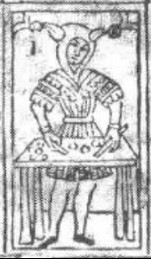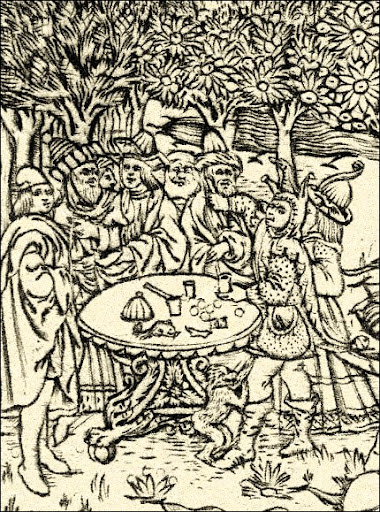It appears in Baldus, Liber Sextus, by Merlinus Cocai alias Teofilo Folengo. I don't know, when Liber Sixtus was written, but this might be well before 1520 (but naturally there are a lot of "ifs" ...).
It's clearly written in playing card context. At another place (the "Zanitonella" text) the word "Taroch" is used as part of the glossary.
Both was found in this text version ...
... I don't know how secure this might be
http://www.archive.org/stream/lemaccher ... g33982.txt
**************************************
Baldus, Liber Sextus ... "tarocco"
Further I found games here ...470 Dicite: per vostramque fidem, mihi dicite verum,
de quantis toto ladris piccantur in orbe,
de quantis linguis, aut occhis, de quot orecchis
beccariae hominum faciuntur iure malorum,
nunquid in ipsorum numero muliercula sola est?
475 Aut si sunt aliquae, naso numerare potestis.
Foemina non, coelum renegans, chiamansque diablum,
noctibus integris stat ludens perdere scudos,
perdere mantellum, camisam, perdere bragam,
sive sbaraino, seu cricca, sive tarocco.
480 Foemina non habitat boscos, non spoiat, amazzat
ladra viandantes, non praticat illa palazzum
peiorem boschis, ut robbet, strazzet, abarret,
scortighet orphanulos nudos, viduasque tapinas.
Foemina non cibat osellazzos carne rapaces,
485 non suppis braccos, non blanco pane levreros;
non quando sentit portam chioccare famatum,
strazzosumque inopem, panisque rogare tochellum:
--Vade--ait,--in pacem, nec voias frangere portam.--
Lib. XXII, l'interrogatorio di Baldo e compagni dinanzi a Culfora
(cfr. lib. XXIV, v. 144 sgg.):
... and games in the text of the ZanitonellaCulphora contremuit corpus tam grande Fracassi.
Interpellat eum: qui sit, quo sanguine natus.
Fracassus secum rodens in corde cathenam
respondit curvans laccam sermone trementi:
--Nomine Sturlonus dicor, sum natus ab uno
nomine Burdacho nato de stirpe gigantum,
qui schazzare Iovem voluerunt de paradiso.--
Culphora plus tremuit talem sentendo parolam.
Postea fatezzas Baldi vultumque galantum
mirabat, latosque humeros, strictumque fiancum.
Cui brancata quasi sub rete Cupidinis inquit:
--Tu quoque qui sensum te prodis habere superbum
da prolem nomenque tuum genus atque tuorum.--
Baldus respondet:--Calicuttus nomine dicor,
natus adulterio monachae fratrisque Stopini.
Me conceperunt gesiae devote sub ara,
postea Plutoni de me fecere sigillum.
Sum devotus ei, donavi corpus et almam.
Ergo meum regem dominumque catare procazzo,
me mare, me tellus, quanto magis astra refudant.
Si non esse dei potero, volo, sumque diabli.--
Has desperati stupuit regina parolas.
Mox qui sint alii semper magis aspra dimandat.
Cingar ait:--Postquam scire optas, o alta Maëstas,
[Maëstas, surripit «i» causa galantariae.]
qui sumus et qualis nostra est generatio, dicam.
Sum scarpacinus, scio repezzare zavattas.
Sed quia disfaciunt dates, tavoleria, cartae,
ac reliqui ludi poveros, mea cuncta zugavi:
martellum, gucchias, lisnam, sparamenta, didalum,
formas et secchiam, spaghi quoque fila, tacones,
post haec ammisi ludendo sponte cerebrum.
Quapropter stygias eo desperatus ad oras.
and this is accompanied by the glossary note 238: "238 non ibi taroch, crica"Dic, Toni, tandem mihi iam rasonem,
ut quid et quare tot in angonais,
215 et tot in rerum straniis bagordis
Mantua saltat?
TO. Mantua est totis melior citadis,
Mantuae gens est bona, liberalis,
Mantuam semper squaquarare sentis,
220 barba Pedrale.
Ista primaios genuit poëtas,
alter in Phoebi beveratur amne,
alterum pleno gregus imbriagat
saepe bigunzo.
225 Hinc cavallorum bona razza nascit,
terra vaccarum nat in amne lactis,
ricca formento, pegoris, olivis,
piscibus, uvis.
Semper in ballis godit et moreschis,
230 hic sonant pivas, cifolos, tiorbas,
hic ve sampognas, pifaros, rubebas,
cagaque cimblos.
Factio non hic gibelina plus quam
ghelfa guardatur, sed amant vicissim,
235 prandeunt, coenant, caciant, osellant,
arma manezant.
Non ibi cartae, tavolerus, atque
non ibi tric trac, crica, sbarainus,
cum quibus giochis iuvenes sedendo
240 corpora guastant.
GA. Ut super montem male barca possat,
utque barozzus male sulcat undas,
hoc facit stessum giovenezza stando
ludere cartis.
245 TO. Mantuae zugant cugolis rodondis,
quas vocat Bressae populus borellas,
quando per cerchi spatium balotta
itque reditque.
Gonfias ballas veluti vesigas
250 solis ad razzos agitant scanellis,
hic batit primus, rebatit secundus,
cazza notatur.
Giostra, bagordus, scrimiaeque ludus
sunt iuventutis godimenta nostrae:
255 vos simelmenter iuvenes de Bressa
statis alegri.
I found another note about "ludere cartis", which possibly is not very relevant ... in Baldus, Liber Octavus
****************695 Est Deus his venter, broda Lex, Scriptura botazzus.
Iamque polita nimis sub descum membra cadebant,
nulla est ulterius vaccarum forma Chiarinae,
ossa iacent, quae intacta canes gattaeque relinquunt.
Iamque comenzarant pingues leccare taeros,
700 non aliter fratres sua vasa lavare solebant.
Frigore zelatum lardum pars grafiat ungis,
pars manicis tunicae fregat, nettatque scudellas.
Post epulas tandem consurgunt ludere cartis,
post cartas scrimmant, post scrimmas saepe merendant.
705 Sic ducit vitam gens haec devota beatam.
Bertezant illos, qui celso in pulpite braiant,
qui soterant mortos, ieiunant, seque flagellant,
vadunt excalci, studiant et mille fusaras
scribunt in libris pro Scotto, contraque Scottum.
Macaronea Fun
Further I found this name: Buttadeus Gratarogna ... my researcher instincts said, that this is NOT a real name, and I guess, this opinion might be reliable. I think, that this is Macaronea Fun.
My curiosity was already raised by Grifalcone (Gri-Falcone) in the Triperuno, when I found, that a figure with similar name was used in the Baldo, "Griffarosto" in the role of an innkeeper in hell.
A figure Buttadeus Gratarogna looks then suspicious, who honors an imaginary author Merlinus Cocai, who appears as Magician in his own book ... that's indeed strange.
I think, that all the names in this part might be fun ...
I found the near word "gratarolibus" in the opening of the BaldusEIUSDEM MAGISTRI ACQUARII LODOLAE AD ILLUSTREM DOMINUM PASARINUM
SCARDUARUM COMITEM, DE VITA ET MORIBUS MERLINI COCAII ET DE INVENTIONE
HUIUS VOLUMINIS.
Dudum, serenissime princeps, adeo meum imbalordasti cervellum, ut tibi
de catatione voluminis huius aliquid ispienare velim, quod de memoriae
cadastris quasi mattus cascarim. Quam ob rem ne tantum mihi amplius
tribuas impazzum, accipe rem, non quam orecchis aut naso audivi,
veruni his manibus pertoccavi. Iam pridem nosti quantum ego sim in
curiosare mundum solicitus, diversasque rerum proprietates; et hoc
herbolattos, dentiumque cavatores, braghirorum conciatores
maximamenter condecet. Accidit nos aliquanti herbolatti Armeniam
versus navigabamus causa retrovandi radices, herbas, lapides,
vermiculos et huiusmodi facendas ad conficiendam tiriacam
bisognatissimas. Erant nobiscum super eandem, medesimamque garavellam,
seu barcam intelligibilius dimandandam, magister Salvanellus
Boccatorta, magister Dimeldeus Zucconus, magister Ioannes Baricocola,
magister Buttadeus Gratarogna, et ego magister Acquarius Lodola. Erant
praeterea quatuor praticatissimi artis physicae giudei: Samuel
videlicet, Nabaioth, Helcana, Ruch. Isti omnes insimul aequoris
schenam traversando schavezzabamus. At pluribus exactis giornis,
ventorum contrariatio tanta surrexit, et pluviarum discrepantibus
ventositatarum fulminibus tanta fluctuatio nos accoiavit quod ad
quandam inhabitatam et inherbosam terram nostra tandem garavella se
nolendo inzappellavit. Ibi ergo nescio quo portu recepti, anxii,
stracchi, affamati, bagnati tandem desmontavimus in sabionigeram
littoris spiazam, et aliquanticulum repossati surreximus ad
investigandam loci proprietatem.
... and here, in book 22 (= 22)Baldus, LIBER PRIMUS
Non tantum menas, lacus o de Garda, bagordum,
quando cridant venti circum casamenta Catulli.
Sunt ibi costerae freschi, tenerique botiri
in quibus ad nubes fumant caldaria centum,
45 plena casoncellis, macaronibus atque foiadis.
Ipsae habitant Nymphae super alti montis aguzzum,
formaiumque tridant gratarolibus usque foratis.
Sollicitant altrae teneros componere gnoccos,
qui per formaium rigolant infrotta tridatum,
50 seque revoltantes de zuffo montis abassum
deventant veluti grosso ventramine buttae.
Baldus, LIBER VIGESIMUS SECUNDUS
and as a glossary note to the Zanitonella ...It fretolosa cohors, spronatque trotone serato
420 non miga zanettos, curtaltos, atque frisones,
sed pro, num dicam? quis credat? nempe cavalcant
quadrupedes ligni scannos, tripedesque scanellos,
fornari gramolas, descos, misasque farinae,
concas, telaros, conocchias, guindala, naspos,
425 cadregas, cassas, cophinos, lettiria, scragnas,
barrillos, secchias, gratarolas, mille novellas.
**********to line 394-96
spadolae, secchiae, gramolae, badili,
rocha cum fuso, gratarola, zappae,
mille pignattae
The internal wordbook of the text gives then these explanations
A "grattugia" is a tool in the kitchen ..._gratare_--grattare, star inoperoso
_gratarola, gratula, gratucchia_--grattugia

.. but if a gratarola really innocently means grattarugia, I've my doubts.
A version of 1683 presents a Mr. "Buttadeus grata rogna"
http://books.google.de/books?id=iVZEAAA ... us&f=false
A version of 1521 also ...
http://books.google.de/books?id=HvM7AAA ... 22&f=false
but "Grata Rogna" seems to have been used only by Merlinus Cocai.
*************
Perhaps our friends with better Latin could say a little bit about this collection ...















